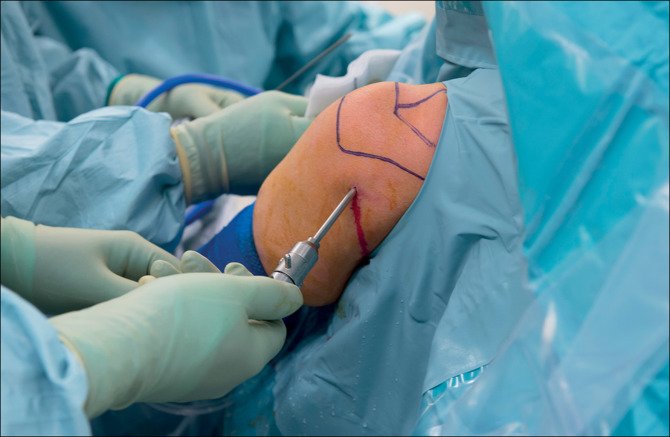
Dr. Sanjay Barik
Knee & Shoulder Surgeon
Meet Our Doctor

Dr. Sanjay Barik
Orthopedic and Joint Replacement Surgeon
Dr. Barik's Orthocare Clinic
- MBBS
- MS - Orthopaedics
Best Shoulder Fracture In Nagpur
Shoulder Trauma:
Shoulder trauma is common and includes injuries ranging from minor avulsions to severe fractures and dislocations. These injuries often result from a variety of accidents, including falls, high-speed motor vehicle collisions, and sports impacts. A thorough understanding of shoulder anatomy is critical to understanding the complexity and subsequent impact of such traumatic events.
Shoulder Anatomy:
The shoulder is made up of three main bones: the scapula (scapula), the clavicle (clavicle), and the humerus (arm bone). These bones are connected to each other by a complex network of soft tissues such as ligaments, tendons, muscles, and joint capsules. The shoulder has three joints: the glenohumeral joint, the acromioclavicular joint, and the sternoclavicular joint. Additionally, the joint between the scapula and the chest wall plays an important role in the overall function of the shoulder.

The glenohumeral joint is a ball and socket joint that serves as the primary joint of the shoulder and consists of the humeral head and the glenoid fossa of the scapula. Soft tissue layers such as the deltoid muscle, the bursa under the deltoid muscle, and the rotator cuff enclose and support the bones, contributing to the mobility and stability of the shoulder.
Types of Shoulder Injuries:
Fractures:
Fractures are fractures of bones that often affect the clavicle, proximal humerus, and scapula.
Clavicle fractures are often caused by a direct impact to the shoulder or a fall.
Proximal humerus fractures occur in the upper part of the humerus and may be associated with high-velocity trauma.
Scapula fractures can occur as a result of severe trauma, such as a high-speed collision with a motor vehicle.
Dislocations:
Dislocations occur when bones become misaligned within a joint and can affect various joints in the shoulder.
Acromioclavicular joint dislocation, also known as a “separated shoulder”, affects the joint between the clavicle and the acromion.
Dislocation of the sternoclavicular joint breaks the connection between the clavicle and the sternum (sternum).
Dislocations of the glenohumeral joint can occur anteriorly (anteriorly) or posteriorly (posteriorly) and can be caused by traumatic events or repetitive stress.
Soft Tissue Injuries:
Soft tissue injuries include tears of ligaments, tendons, muscles, and joint capsules.
Rotator cuff tears, which affect the tendons that facilitate shoulder movement, are a common soft tissue injury.
Labral tears affect the cartilaginous end (labrum) of the glenohumeral joint and can result from trauma or repetitive overhead activities.
Understanding the diverse range of shoulder injuries, from fractures to dislocations to soft tissue injuries, is important for accurate diagnosis, appropriate treatment, and effective rehabilitation. This comprehensive knowledge benefits both medical professionals and individuals to ensure optimal care and recovery after shoulder trauma.
Shoulder injuries such as fractures, dislocations, and separations commonly occur as a result of a variety of traumatic events. Understanding the causes, symptoms, and treatments for these injuries is important for effective treatment. This comprehensive overview covers complex structures such as fractures of the clavicle, proximal humerus, and scapula, as well as shoulder dislocations and shoulder separations.
Cause:
Fracture:
Fractures of the clavicle or proximal humerus usually result from a direct blow to the shoulder area from a fall, collision, or motor vehicle accident. In contrast, scapular fractures are well-protected and are usually the result of high-energy trauma such as: B. High-speed motor vehicle collisions that often result in chest injuries.
Shoulder Dislocation:
Anterior dislocation of the shoulder occurs when the arm is forced to rotate outward, often as a result of a fall or a direct impact to the shoulder. Posterior dislocations are less common but are often accompanied by seizures or electric shocks that cause strong contractions of the shoulder muscles.
Shoulder Separation:
Dislocation of the acromioclavicular joint, often incorrectly referred to as “shoulder separation”, is usually caused by falling on the shoulder or lifting something heavy. It is important to note that the affected joint is not the primary shoulder joint.
Symptoms:
Symptoms vary depending on the type of shoulder injury:
Common symptoms:
- Pain
- Swelling and bruising
- Inability to move the shoulder
- Crepitus during shoulder movements
- Deformity
Symptoms specific to various fractures and dislocations:
Clavicle fracture: swelling, bruising, prominence in the clavicle area, limited range of motion of the shoulder.
Proximal humerus fracture: Severe swelling of the shoulder, limited mobility, severe pain, and bruising of the upper arm.
Scapula fracture: pain, swelling and severe bruising in the scapula area.
Shoulder Separation: Pain in the upper part of the shoulder, a protrusion or bump in the upper part of the shoulder.
Shoulder Dislocation: A protrusion or bump on the front of the shoulder, inability to move the arm, arm rotating outward, feeling like a “dead arm”.
Treatment:
Clavicle Fracture:
Nonsurgical treatment is common.
Severe fractures may require surgical intervention requiring fixation with plates, screws, or rods.
Proximal humerus fractures:
Nonsurgical treatment to reduce displaced fractures.
Surgery includes fixation with plates, screws, pins, or shoulder replacement.
Scapula Fractures:
Nonsurgical treatment with immobilization, icing, and pain medications is standard.
Surgical intervention is considered in severe cases with joint fragmentation and clavicle fractures.
Shoulder separation (acromioclavicular joint):
Mild cases are treated without surgery.
In severe cases, especially in cases of upward movement or dislocation, surgery may be required to repair or reconstruct the ligament.
Shoulder dislocation (glenohumeral joint):
Initial treatment is reduction of the dislocation in the emergency room.
Patients younger than 25 years of age or those with persistent instability often require soft tissue repair surgery.
Understanding the causes, symptoms, and treatment of shoulder injuries is important for both healthcare professionals and the general public. Early diagnosis and appropriate intervention can have a significant impact on the recovery and long-term function of the shoulder joint. Anyone suffering from shoulder trauma or pain should seek immediate medical attention to determine the most appropriate course of action for their particular condition.


